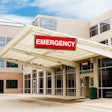Legislation to create a national imaging institute sailed through a crucial U.S. House subcommittee hearing yesterday, and a full Commerce Committee hearing today could seal the bill's fate, AuntMinnie.com has learned.
"We hope it will be approved at that time," said Edward Nagy, executive director of the Academy of Radiology Research, a Washington, DC-based lobbying group that has led efforts to establish a national medical imaging institute in the U.S.
Commerce Committee approval would make the legislation, (H.R. 1795) eligible for a vote by the full U.S. House of Representatives. With luck, both houses of Congress could pass laws authorizing the institute before the current legislative session ends in October, Nagy said.
Twenty-nine members of the Subcommittee on Health and Environment heard testimony yesterday in favor of the bill and its nearly-identical Senate counterpart, S. 1110. Three prominent U.S. radiologists said the institute was essential for advancing basic imaging research.
Dr. N. Reed Dunnick, radiology department chair at the University of Michigan hospitals, said that while several departments of the U. S. National Institutes of Health (NIH), and federal agencies such as NSF, NASA, the intelligence agencies, the Departments of Defense, Commerce and Energy all support imaging research, their efforts are unfocused.
"This lack of coordination not only encourages duplication and inefficiency, it impedes the transfer of imaging technologies from research projects to the public health care sector," Dunnick testified. "The proposed institute could do much to ensure that federal research dollars are expended more efficiently and productively."
Dr. Bruce Hillman, radiology department chair at the University of Virginia School of Medicine and chancellor of the American College of Radiology, said an impending molecular revolution in medicine will see the development of amazing tools to diagnose and treat disease at its earliest stages.
However, medical imaging, the "noninvasive biopsy" that will form the underpinnings of molecular medicine, must undergo broad-based research in order to fulfill that promise, Hillman said. Because imaging technologies are multi-potential, the organ- and disease-specific approach of the NIH is ill-equipped to handle the challenge.
"Basic research into the development of new imaging opportunities has been subject to overlap and duplication, inefficient use of resources, and lost opportunities," Hillman testified. "The initial invention and basic research into new technologies ... CAT scanning, MRI, and image-guided interventional methods, have most frequently occurred outside the U.S., where the logistics and funding of basic research can be handled in a more straightforward fashion."
The radiologists agreed that an imaging institute would correct critical structural flaws and concentrate research efforts where they are most needed.
"In order to flourish and grow consistently at the NIH, a scientific field requires an organization with the mandate, the responsibility, the authority, and the resources to direct ... investigation in that field. In the NIH, only institutes possess those attributes," said Dr. Nick Bryan, radiology department chair of the University of Pennsylvania Health Systems.
While the federal government did not send a representative to testify at the hearing, the Clinton administration filed written testimony opposing the creation of an institute. The document noted that during fiscal 1998, the last year for which final figures are available, Congress spent approximately $339 million on what it calls "bioimaging research." Together with related bioengineering expenditures, the government wrote, federal investment in basic research was substantial and growing.
Moreover, the disease-specific approach is both logical and highly successful, the government stated.
"There are many examples in the various institutes over the past several years in which significant discovery has occurred because of collaborations between physical scientists and biological scientists aimed at solving specific biological questions," the document stated.
Still, there appears to be strong support for the institute among radiologists. In the past week more than 2,200 AuntMinnie.com users have signed an online petition in favor of the institute. The Academy of Radiology Research said more than 13,000 people have expressed support for the initiative since its lobbying efforts began. The academy is urging the radiology community to fax letters in favor of the institute to U.S. legislators. More information is available at www.acadrad.org.
For his part, Nagy says he is hopeful about the legislation following yesterday's hearing.
"It went very well," he said. "Bryan, Dunnick and Hillman made a telling case for the institute, and several members of the committee made supportive opening statements. We're not aware of any opposition on the committee, so at this point we're feeling very good about it."
By Eric Barnes
AuntMinnie.com staff writer
September 14, 2000
Related Reading
House subcommittee to tackle proposed NIH imaging institute, September 11, 2000
More NIH funds could aid imaging effort, January 25, 2000
Radiology accelerates drive for imaging institute in 2000, January 11, 2000
Let AuntMinnie.com know what you think about this story.
Copyright © 2000 AuntMinnie.com

















